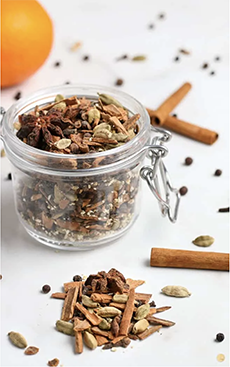Mulled Wine Sorbet Recipe For National Mulled Wine Day
|
|
March 3rd is National Mulled Wine Day. There are related holidays: National Hot Toddy Day is January 11th, National Hot Buttered Rum Day is January 17th, and National Hot Mulled Cider Day is September 30th. There is no National Glogg Day, but glogg is the Swedish word for mulled wine. These drinks are almost identical. A hot toddy can be made from any whiskey; the other drinks are the same concept made with cider, rum, and wine. If you like one, you’ll like them all (although perhaps some might hold the pat of butter in the hot buttered rum). We have mulled wine recipes below. But for a twist, how about some mulled wine sorbet? The recipe is below. But first… > The difference between glögg, hot buttered run, mulled wine, toddy, and more. > The history of mulled wine. According to Harvard University, the origin of the word “mull” to mean heated and spiced is shrouded in mystery. Mulling spices can include allspice, cardamom, cinnamon, cloves, nutmeg, peppercorns, and/or star anise. A “mulled” drink is one that has been prepared with these spices. The same spices used for mulled cider and wine can be added to the brewing process to make spiced beer. The custom of flavoring wine and beer with spices is believed to have originated in northern Europe to extend the use of wine that had gone bad. The spices covered up the off-taste and aromas. The expression “cup of good cheer” comes to us from Merrie Olde England, referring to hot mulled cider and wine. The technique is to heat the liquids with the spices and then strain them out before serving. Fruits were often added to the brew or as a garnish, including apples, oranges, and dried fruits, including raisins. In some countries, almonds and raisins are placed in the bottom of the mug or glass before the hot wine is added. > Mulled wine history. If you don’t own an ice cream maker, you can prepare this recipe as a granita. See the variation after Step 6. 1. COMBINE the red wine, cinnamon sticks, anise seed, cloves, nutmeg, water, and sugar in a large saucepan over medium heat. 2. SLICE the lemons and orange in half. Juice the fruit over the wine mixture and add the rinds to the saucepan. 3. SLICE the vanilla bean lengthwise. Remove the seeds from the bean and add both the seeds and bean to the wine mixture. Bring the mixture to a boil and cook for about 10 minutes. Remove the pot from the heat and let cool. 4. POUR the mixture into a fine-mesh sieve lined with cheesecloth and hung over a large bowl. Discard the solids and cheesecloth and let the liquid cool to room temperature. Refrigerate it for a minimum of 12 hours. 5. PROCESS the mixture in your ice cream maker, according to the manufacturer’s instructions. 6. SERVE immediately; or freeze as desired. If you want to serve the sorbet that day but want a thicker consistency, place the sorbet in the freezer until the desired consistency is reached. After Step 4, place the mixture in a large glass baking dish (not metal). Place it on a level surface in the freezer. Using a fork, stir the mixture often during the freezing process to ensure that large ice crystals do not form. The more frozen the sorbet becomes, the less stirring it will require. |
|
|
CHECK OUT WHAT’S HAPPENING ON OUR HOME PAGE, THENIBBLE.COM.
|
||







